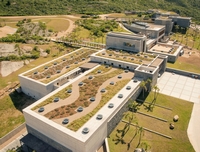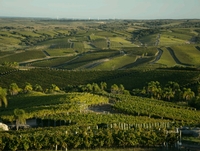The rugged, undeveloped site purchased by the Bulgheronis was 11 miles from the Atlantic Ocean and even closer to the glamorous seaside resort of Punte del Este and the smaller, more laid-back resort town of José Ignacio. Alejandro’s idea was to make it a wind farm—an idea not shared by Bettina. So, as he considered other options, an advisor suggested that the property would be great for vineyards. An Argentine friend who owned a winery in Mendoza counseled Bulgheroni to talk to Tuscan enologist Alberto Antonini. The combination of the highly respected Antonini’s wine knowledge and and Bulgheroni’s business savvy and growing curiosity about wine production was formidable. Thus began the warp-speed construction of a wine empire that only a billionaire could finance. Fortunately, this billionaire has good taste and environmental ethics.
For one thing, the property, including the construction of a 205,000-square-foot, state-of-the-art winery, was developed to enhance biodiversity and to blend into the environment using a process that would merit a LEED (Leadership in Energy and Environmental Design) certification, the most widely used green building rating system in the world. A description of just a few of the efforts of the construction team follows: Removal of invasive plant species that were crowding out native plants; sourcing materials locally such  as handmade tapestry and products from stone workers to reduce the carbon footprint and help the local economy; harvesting water for winemaking, hospitality, building systems and landscaping needs, and treatment of effluents with bioreactor membranes with no chemicals being used, before returning quality irrigation water to the site. One of my favorite efforts was finding native vegetation on the property and cultivating it to produce 70,000 plants, creating the beautiful living roofs on their buildings. Needless to say, LEED certifications are not handed out like candy.
as handmade tapestry and products from stone workers to reduce the carbon footprint and help the local economy; harvesting water for winemaking, hospitality, building systems and landscaping needs, and treatment of effluents with bioreactor membranes with no chemicals being used, before returning quality irrigation water to the site. One of my favorite efforts was finding native vegetation on the property and cultivating it to produce 70,000 plants, creating the beautiful living roofs on their buildings. Needless to say, LEED certifications are not handed out like candy.
In 2009, Bodega Garzon received a LEED Silver certification for New Construction and Major Renovations. Furthermore, it is the first winery facility LEED – USGBC certified outside USA, with the highest score in water efficiency, as well as the first whole facility LEED certified in the world, winery with the highest percentage of Regional materials use and the biggest green roof with native species in Latin America. When Mr. Bulgheroni decides to do something, he goes all out.
Today, Bodega Garzon has 500-acres of vineyards planted in 1000-plus plots with white grapes on south-facing plots and red grapes in north-facing plots. The property is in Maldonado, a department or province of Uruguay.  Maldenado is in the Eastern Zone of Uruguay’s wine production, and is higher in altitude and with greater biodiversity and more diverse soil types than the other four regions. The area close to the Garzón Lagoon has some of the oldest soils on the planet, and the ballast soil of the region is very soft with excellent drainage and permeability, and multiple minerals. These are ideal conditions for growing fine wine grapes like Tannat, Cabernet Franc, Pinot Noir, Merlot, Marselan, Caladoc, Sauvignon Blanc, Albariño, Petit Manseng, among others.
Maldenado is in the Eastern Zone of Uruguay’s wine production, and is higher in altitude and with greater biodiversity and more diverse soil types than the other four regions. The area close to the Garzón Lagoon has some of the oldest soils on the planet, and the ballast soil of the region is very soft with excellent drainage and permeability, and multiple minerals. These are ideal conditions for growing fine wine grapes like Tannat, Cabernet Franc, Pinot Noir, Merlot, Marselan, Caladoc, Sauvignon Blanc, Albariño, Petit Manseng, among others.
I mentioned the wine empire. It wasn’t long into the Garzon project that Mr. Bulgheroni began accumulating wine estates throughout the world. His first after Garzon was Vistalba in Mendoza, Argentina. Also in Argentina he acquired Argento in Mendoza and Sarmiento in Patagonia. Following the advice of his consulting winemaker, Alberto Antonini, he added the Tuscan estates of Dievole and Certosa di Pontignano in Chianti Classico. He has Poggio Landi and Poderi Brizio in Montalcino, and Tenuta Meraviglia and Tenuta Le Colonne in Bolgheri. Then there is Château Suau and Château de Langalerie in Bordeaux, Renwood and Alejandro Bulgheroni Estate in California, and Greenock Farm vineyard in Barossa Valley. Asked why he started adding these wineries to his portfolio, he indicated that just having one winery in Uruguay might not give him gravitas in the wine world. And, to be taken seriously in China, he HAD to have a Bordeaux. Then, to get attention in the US, he needed a Napa Valley wine.
I had the opportunity to visit the amazing Garzon property and the gorgeous surrounding area late last year with a group of writers. I had never been to Uruguay, and indeed had to look it up on a map. I only visited a small area, but I admired its beauty. I was very impressed by the scope of the Bodega Garzon property. My camera could not capture the magnitude.
We tasted several wines with Christian Wylie, Managing Director of Garzon. Some of my favorites follow. The Single Vineyard Sauvignon Blanc 2019, fermented in concrete tulip shaped tanks, rested on lees for eight months to add texture showed luscious pineapple, peach fruit with a touch of fresh herbs in the mouth, clean and crisp with mouthwatering acidity. The Reserva Albariño 2019 ($17) fermented in concrete tulip shaped tanks, with 20 percent aged on lees in oak barrels was juicy, ripe and round with peach, pineapple fruit and bright acidity. The Reserva Tannat 2018 ($17) with six to 12 months on the lees in previously used untoasted French oak barrels and casks had a deep ruby color a spicy plum, blackberry nose with an intense herbal note, plum flavors in the mouth well integrated with the oak. Balasto 2017 ($99), named for vineyard soil, is their flagship wine. It’s a blend of 50 percent Tannat, 40 percent Cabernet Franc and the final 10 percent is equal parts Marselan and Merlot. Initially the wine was quite shy, but after 15-20 minutes in the glass, it began to reveal dense black cherry, cassis fruit in a firm structure, well balanced with freshness from tangy acidity, finishing with fine-grained tannins. It’s what you want to see from a serious winery.
Alejandro Bulgheroni may have come late to the wine scene, but he’s a real player now.
